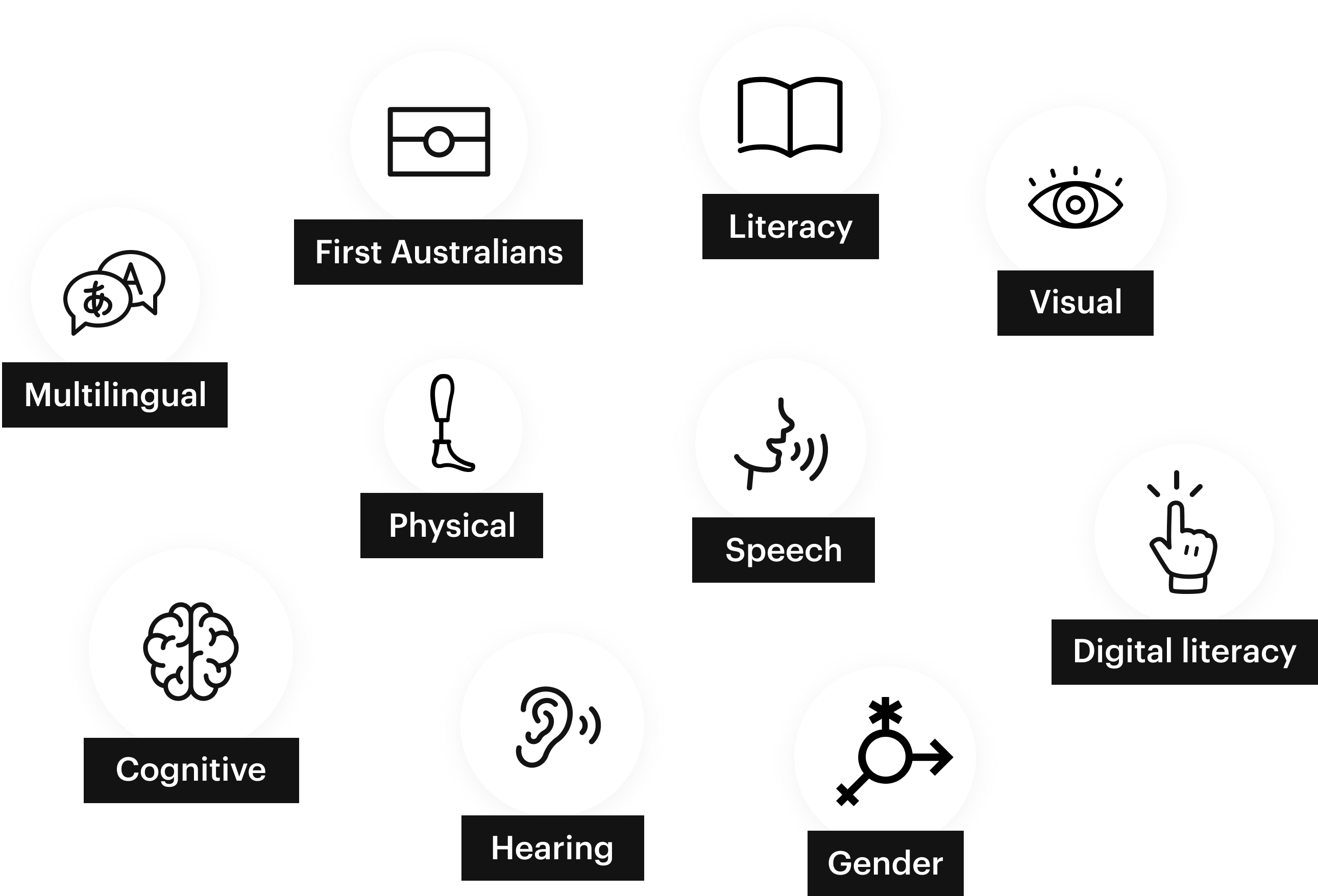Inclusive by Design: Building better products and websites for all
Here at Pollen, we are firm advocates that the projects we are involved in should have inclusive design principles instilled in them to provide the widest possible level of engagement with a diverse range of users.
Inclusive Design was defined in 2000 by the UK Government as "products, services and environments that include the needs of the widest number of consumers".

As designers, our work is made up of hundreds of decisions that potentially have the power to either include or exclude people. Inclusive design starts by getting to know your users and all their diverse needs, and using this knowledge to inform design decisions.
Whilst it is all about designing for the user (and where possible with the user), it is also a smart business strategy. By designing for the needs of marginalised users, we can meet a much larger market demand. The Centre for Inclusive Design estimates that at least five million Australians are vulnerable to exclusion, yet they possess over $40 billion in annual disposable income. That’s a largely untapped opportunity for many businesses.
The principle of providing an adaptable experience that caters for multiple audiences is at the heart of inclusive design. Only by understanding everybody's cultural background, literacy level, disability barriers, age and technical matureness can we design and build experiences that can include as many people as possible.
No one wants to be left out, be defined by, or be treated differently based on their ability.
Our process begins by defining who our audience is to better understand their needs and to then design systems and processes that cater to them. This enables us to design the appropriate experience. Inclusive audiences are not defined by one ability but often can be a combination of these inclusive abilities.
Types inclusive users

Visual
Colour blindness, low vision and blindness
Cognitive (Learning)
ADHD, autism, dyslexia, seizures
Hearing
Hard of hearing and deafness
Physical
Amputation, paralysis and hand tremors
Speech Impediments
Muteness and stuttering
CALD/Multilingual
Culturally and linguistically diverse audience, English as a second language
First Australians
Cultural sensitivities
Digital literacy
Access, skills, device capabilities
Low literacy
Is defined as literacy levels 3 and below (year 5 school level)
Gender identity
Is a personal conception of oneself as male or female or neither and how this is expressed
Being aware of these contexts enables a greater awareness around how experience, design and content can cater to a wider set of needs.

Throughout our projects, we employ key inclusive design principles that help us serve the needs of the wider community:
Inclusivity over form
Inclusivity shouldn't hinder creative expression. Thinking inclusive first sharpens the clarity of your objectives. Your content, your interface and your technology choices become the sandbox of creativity; not boundaries to creative expression.
Inclusivity with dignity
Aiming for a one size fits all approach is difficult. Instead aim for a patchwork of methods to ensure your experience is representative of the widest audience possible, and that no one audience is singled out.
Engage with innovative storytelling
Stories are what unite us with each other. Great stories that are told with inclusivity in mind and have the ability to connect and unite despite our differences. By considering how your story will resonate with different audiences, it may in fact make a more compelling experience for all.
One primary action per screen
Taking a “Less is more” approach with a streamlined design and clear hierarchy ensures clarity and access to your messages and services. Designing mobile-first, aids this process, enforcing stricter prioritisation for the smaller screen.
We live by these principles and are mindful to instil an inclusive perspective into the projects we are part of.
Critical to the success of any project we are engaged in is the collaborative relationships we establish with our clients. Only through a shared understanding of inclusive design can we create more inclusive experiences for all. Below are three inclusive projects that highlight the importance of having a shared ambition to create better outcomes for the widest possible audience.
Telling Sydney’s History
Working closely with Sydney Living Museums, we were tasked to create a Digital Inclusivity Plan that outlined how to create inclusive designs and content for the Hyde Park Barracks Museum. The impact of this work enabled a wider audience to connect with the stories of Sydney's history.
Creating design consistency across the NSW government
The Department of Customer Service engaged Pollen to address inconsistencies in their digital brand guidelines. Through usability testing, we pressure tested the Design System with participants with a range of disabilities including colour blindness, blurred vision, memory issues, ADHD and autism. Through this approach, Pollen assisted in creating a Digital Design System that achieved consistency and efficiency for the various government departments that catered to the inclusive needs of NSW citizens.
Communicating effectively to an older audience
In-home aged care and disability support providers, KinCare, tasked us to undertake an accessibility audit on their website. The goal was to take a pulse check of the current site in light of new insights into accessibility best practices. Targeting an elderly audience, we had to consider multiple disabilities users may have and had completed a content and technical audit adhering to WCAG 2.1 accessibility standards.
In conclusion, when designing and building experiences that can include as many people as possible, inclusive design is about maximising your potential audience and creating better products whatever situation your users find themselves in. At Pollen, we see it as a spectrum of opportunity that you and your business can tap into and be supportive of.



